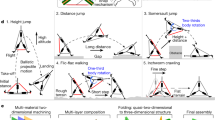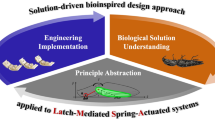Abstract
Research on mobile millirobots has been ongoing for the last 20 years, but the few robots that have walked have done so at slow speeds on smooth silicon wafers. However, ants can move at speeds approaching 40 body lengths/second on surfaces from picnic tables to front lawns. What challenges do we still need to tackle for millirobots to achieve this incredible mobility? This chapter presents some of the mechanisms that have been designed and fabricated to enable robot mobility at the insect size scale. These mechanisms utilize new microfabrication processes to incorporate materials with widely varying moduli and functionality for more complexity in smaller packages. Results include a 4 mm jumping mechanism that can be launched over 30 cm straight up, an actuated jumping mechanism used as a catapult, and preliminary leg designs for a walking/running millirobot.
Access this chapter
Tax calculation will be finalised at checkout
Purchases are for personal use only
Preview
Unable to display preview. Download preview PDF.
Similar content being viewed by others
References
Full, R.J., Tu, M.S.: Mechanics of a rapid running insect: two-, four- and six-legged locomotion. The Journal of Experimental Biology 156, 215–231 (1991)
Seidl, T., Wehner, R.: Walking on inclines: how do desert ants monitor slope and step length. Frontiers in Zoology 5(1), 8 (2008)
Burrows, M.: Froghopper insects leap to new heights. Nature 424, 509 (2003)
Dudek, D.M.: Passive mechanical properties of the exoskeleton simplify the control of rapid running in the cockroach, Blaberus discoidalis. PhD dissertation, University of California, Berkeley (2006)
Kubow, T., Full, R.: The role of the mechanical system in control: A hypothesis of self-stabilization in hexapedal runners. Philosophical Transactions of the Royal Society London B 354, 849–862 (1999)
Spagna, J.C., Goldman, D.I., Lin, P.C., Koditschek, D.E., Full, R.J.: Distributed mechanical feedback in arthropods and robots simplifies control of rapid running on challenging terrain. Bioinspiration & Biomimetics 2, 9–18 (2007)
Noh, M., Kim, S.W., An, S., Koh, J.S., Cho, K.J.: Flea-inspired catapult mechanism for miniature jumping robots. IEEE Transactions on Robotics 28(5), 1007–1018 (2012)
Brown, I., Loeb, G.: A reductionist approach to creating and using neuromusculoskeletal models. In: Biomechanics and Neuro-Control of Posture and Movement, pp. 148–163. Springer, New York (2000)
Saranli, U., Buehler, M., Koditschek, D.E.: Design, modeling and preliminary control of a compliant hexapod robot. In: IEEE International Conference on Robotics and Automation, San Francisco, CA (2000)
Saranli, U., Buehler, M., Koditschek, D.E.: RHex: a simple and highly mobile hexapod robot. International Journal of Robotics Research 20(7), 616–631 (2001)
Cham, J.G., Bailey, S.A., Cutkosky, M.R.: Robust dynamic locomotion through feedforward-preflex interaction. In: ASME International Mechanical Engineering Congress and Expo (November 2000)
Yeh, R., Kruglick, E.J.J., Pister, K.S.J.: Surface-micromachined components for articulated microrobots. Journal of Microelectromechanical Systems 5(1), 10–17 (1996)
Kladitis, P.E., Bright, V.M.: Prototype microrobots for micro-positioning and micro-unmanned vehicles. Sensors and Actuators A: Physical 80(2), 132–137 (2000)
Hollar, S., Flynn, A.M., Bellew, C., Pister, K.S.J.: Solar powered 10 mg silicon robot. In: IEEE Micro Electro Mechanical Systems, pp. 706–711 (2003)
Hollar, S., Flynn, A.M., Bergbreiter, S., Pister, K.S.J.: Robot leg motion in a Planarized-SOI 2 poly process, Hilton Head, SC (June 2002)
Petersen, K.E.: Silicon as a mechanical material. Proceedings of the IEEE 70(5), 420–457 (1982)
Ebefors, T., Mattsson, J.U., Kalvesten, E., Stemme, G.: A walking silicon microrobot. In: International Conference on Solid-State Sensors, Actuators, and Microsystes (Transducers), Sendai, Japan, pp. 1202–1205 (June 1999)
Ebefors, T., Ulfstedt-Mattsson, J., Kalvesten, E., Stemme, G.: 3D micromachined devices based on polyimide joint technology. In: Conference on Devices and Process Technologies for MEMS and Microelectronics, SPIE, Gold Coast, Australia, vol. 3892, pp. 118–132 (October 1999)
Erdem, E.Y., Chen, Y.M., Mohebbi, M., Suh, J.W., Kovacs, G.T.A., Darling, R.B., Bohringer, K.F.: Thermally actuated omnidirectional walking microrobot. Journal of Microelectromechanical Systems 19(3), 433–442 (2010)
Wood, R.J.: The first takeoff of a biologically inspired at-scale robotic insect. IEEE Transactions on Robotics 24(2), 341–347 (2008)
Schneider, F., Fellner, T., Wilde, J., Wallrabe, U.: Mechanical properties of silicones for MEMS. Journal of Micromechanics and Microengineering 18(6), 065008 (2008)
Xia, Y., Whitesides, G.M.: Soft lithography. Annual Review of Materials Science 28(1), 153–184 (1998)
Suzuki, Y., Tai, Y.C.: Micromachined high-aspect-ratio parylene spring and its application to low-frequency accelerometers. Journal of Microelectromechanical Systems 15(5), 1364–1370 (2006)
Wood, R.J., Avadhanula, S., Sahai, R., Steltz, E., Fearing, R.S.: Microrobot design using fiber reinforced composites. Journal of Mechanical Design 130(5), 052304 (2008)
Gerratt, A.P., Bergbreiter, S.: Incorporating compliant elastomers for jumping locomotion in microrobots. Smart Materials and Structures 22(1), 014010 (2013)
Lee, J.N., Park, C., Whitesides, G.M.: Solvent compatibility of poly(dimethylsiloxane)-sased microfluidic devices. Analytical Chemistry 75(23), 6544–6554 (2003)
Gerratt, A.P., Penskiy, I., Bergbreiter, S.: In situ characterization of PDMS in SOI-MEMS. Journal of Micromechanics and Microengineering 23(4), 045003 (2013)
Bergbreiter, S.: Effective and efficient locomotion for millimeter-sized microrobots. In: IEEE/RSJ International Conference on Intelligent Robots and Systems, Nice, France, pp. 4030–4035 (September 2008)
Churaman, W.A., Gerratt, A.P., Bergbreiter, S.: First leaps toward jumping microrobots. In: IEEE/RSJ International Conference on Intelligent Robots and Systems, San Francisco, CA, USA, pp. 1680–1686 (September 2011)
Burdick, J., Fiorini, P.: Minimalist jumping robots for celestial exploration. The International Journal of Robotics Research 22(78), 653–674 (2003)
Braunig, P., Burrows, M.: Neurons controlling jumping in froghopper insects. The Journal of Comparative Neurology 507(1), 1065–1075 (2008)
Burrows, M.: Morphology and action of the hind leg joints controlling jumping in froghopper insect. Journal of Experimental Biology 209, 4622–4637 (2006)
Maloney, J.M., Schreiber, D.S., DeVoe, D.L.: Large-force electrothermal linear micromotors. Journal of Micromechanics and Microengineering 14, 226–234 (2004)
Howell, L.L.: Compliant Mechanisms. John Wiley & Sons, Inc., New York (2001)
Vogtmann, D., Gupta, S.K., Bergbreiter, S.: Characterization and modeling of elastomeric joints in miniature compliant mechanisms. ASME Journal of Mechanisms and Robotics 5(4), 41017 (2013)
Author information
Authors and Affiliations
Editor information
Editors and Affiliations
Rights and permissions
Copyright information
© 2014 Springer-Verlag Berlin Heidelberg
About this paper
Cite this paper
Bergbreiter, S., Gerratt, A.P., Vogtmann, D. (2014). Progress Toward Mobility in Microfabricated Millirobots. In: Paprotny, I., Bergbreiter, S. (eds) Small-Scale Robotics. From Nano-to-Millimeter-Sized Robotic Systems and Applications. ICRA 2013. Lecture Notes in Computer Science(), vol 8336. Springer, Berlin, Heidelberg. https://doi.org/10.1007/978-3-642-55134-5_4
Download citation
DOI: https://doi.org/10.1007/978-3-642-55134-5_4
Publisher Name: Springer, Berlin, Heidelberg
Print ISBN: 978-3-642-55133-8
Online ISBN: 978-3-642-55134-5
eBook Packages: Computer ScienceComputer Science (R0)




